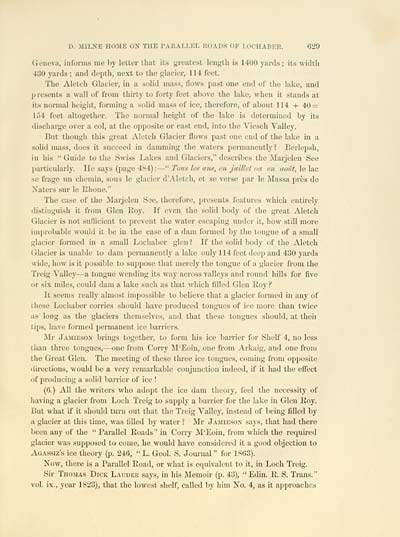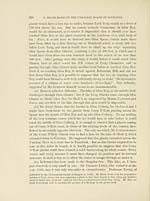Download files
Complete book:
Individual page:
Thumbnail gallery: Grid view | List view

D. MILNE HOME ON THE FAEALLEL ROADS OF LOCHABEP.. 629
Geneva, informs me by letter that its greatest length is 1400 yards ; its width
430 yards ; and depth, next to the glacier, 114 feet.
The Aletch Glacier, in a solid mass, flows past one end of the lake, and
presents a wall of from thirty to forty feet above the lake, when it stands at
its normal height, forming a solid mass of ice, therefore, of about 114 + 40 =
154 feet altogether. The normal height of the lake is determined by its
discharge over a col, at the opposite or east end, into the Viescli Valley.
But though this great Aletch Glacier flows jjast one end of the lake in a
solid mass, does it succeed in damming the waters permanently? Berlepsh,
in his " Guide to the Swiss Lakes and Glaciers," describes the Marjelen See
particularly. He says (page 484) : — " Tous les am, en juillet ua en aoAt, le lac
se frage un chemin, sous le glacier d'Aletch, et se verse par le Massa j^res de
Xaters sur le Rhone."
The case of the Marjelen See, therefore, presents features which entu-ely
distinguish it from Glen Roy. If even the solid body of the great Aletch
Glacier is not sufficient to prevent the water escaping under it, how still more
improbable would it be in the case of a dam formed by the tongue of a small
glacier formed in a small Locliaber glenl If the solid body of the Aletch
Glacier is unable to dam pernianentlj' a lake only 114 feet deep and 430 yards
wide, how is it possible to supjDOse that merely the tongue of a glacier from the
Treig Valley — a tongue wending its Avay across valleys and round hills for five
or six miles, could dam a lake such as that which filled Glen Roy ?
It seems really almost impossible to believe that a glacier formed in any of
these Lochaber corries should have produced tongues of ir-e more than twice
as long as the glaciers themselves, and that these tongues should, at theii
tips, have formed permanent ice barriers.
]\Ir Jajviieson brings together, to form his ice bai-rier for Shelf 4, no less
than three tongues, — one from Corry M'Eoin, one from Arkaig, and one from
the Great Glen. The meeting of these three ice tongues, coming from ojjposite
du'ections, would be a very remarkable conjunction indeed, if it had the effect
of producing a solid barrier of ice !
(6.) All the writers who adopt the ice dam theory, feel the necessity of
ha\ing a glacier from Loch Treig to sujjply a barrier for the lake in Glen Roy.
But what if it should turn out that the Treig Valley, instead of being filled by
a glacier at this time, was filled by water ? Mr Jamieson says, that had there
been any of the " Parallel Roads" in Corry M'Eoin, from which the required
glacier was supposed to come, he would have considered it a good objection to
Agassiz's ice theory (p. 246, "L. Geol. S. Jomual " for 1S63).
Now, there is a Parallel Road, or what is equivalent to it, in Loch Treig.
Sir Thomas Dick Lauder says, in his Memoir (p. 43), " Edin. R. S. Trans."
vol. ix., year 1823), that the lowest shelf, called by him No. 4, as it approaches
Geneva, informs me by letter that its greatest length is 1400 yards ; its width
430 yards ; and depth, next to the glacier, 114 feet.
The Aletch Glacier, in a solid mass, flows past one end of the lake, and
presents a wall of from thirty to forty feet above the lake, when it stands at
its normal height, forming a solid mass of ice, therefore, of about 114 + 40 =
154 feet altogether. The normal height of the lake is determined by its
discharge over a col, at the opposite or east end, into the Viescli Valley.
But though this great Aletch Glacier flows jjast one end of the lake in a
solid mass, does it succeed in damming the waters permanently? Berlepsh,
in his " Guide to the Swiss Lakes and Glaciers," describes the Marjelen See
particularly. He says (page 484) : — " Tous les am, en juillet ua en aoAt, le lac
se frage un chemin, sous le glacier d'Aletch, et se verse par le Massa j^res de
Xaters sur le Rhone."
The case of the Marjelen See, therefore, presents features which entu-ely
distinguish it from Glen Roy. If even the solid body of the great Aletch
Glacier is not sufficient to prevent the water escaping under it, how still more
improbable would it be in the case of a dam formed by the tongue of a small
glacier formed in a small Locliaber glenl If the solid body of the Aletch
Glacier is unable to dam pernianentlj' a lake only 114 feet deep and 430 yards
wide, how is it possible to supjDOse that merely the tongue of a glacier from the
Treig Valley — a tongue wending its Avay across valleys and round hills for five
or six miles, could dam a lake such as that which filled Glen Roy ?
It seems really almost impossible to believe that a glacier formed in any of
these Lochaber corries should have produced tongues of ir-e more than twice
as long as the glaciers themselves, and that these tongues should, at theii
tips, have formed permanent ice barriers.
]\Ir Jajviieson brings together, to form his ice bai-rier for Shelf 4, no less
than three tongues, — one from Corry M'Eoin, one from Arkaig, and one from
the Great Glen. The meeting of these three ice tongues, coming from ojjposite
du'ections, would be a very remarkable conjunction indeed, if it had the effect
of producing a solid barrier of ice !
(6.) All the writers who adopt the ice dam theory, feel the necessity of
ha\ing a glacier from Loch Treig to sujjply a barrier for the lake in Glen Roy.
But what if it should turn out that the Treig Valley, instead of being filled by
a glacier at this time, was filled by water ? Mr Jamieson says, that had there
been any of the " Parallel Roads" in Corry M'Eoin, from which the required
glacier was supposed to come, he would have considered it a good objection to
Agassiz's ice theory (p. 246, "L. Geol. S. Jomual " for 1S63).
Now, there is a Parallel Road, or what is equivalent to it, in Loch Treig.
Sir Thomas Dick Lauder says, in his Memoir (p. 43), " Edin. R. S. Trans."
vol. ix., year 1823), that the lowest shelf, called by him No. 4, as it approaches
Set display mode to: Large image | Transcription
Images and transcriptions on this page, including medium image downloads, may be used under the Creative Commons Attribution 4.0 International Licence unless otherwise stated. ![]()
| Early Gaelic Book Collections > J. F. Campbell Collection > On the parallel roads of Lochaber > (53) |
|---|
| Permanent URL | https://digital.nls.uk/80970646 |
|---|
| Description | Volumes from a collection of 610 books rich in Highland folklore, Ossianic literature and other Celtic subjects. Many of the books annotated by John Francis Campbell of Islay, who assembled the collection. |
|---|
| Description | Selected items from five 'Special and Named Printed Collections'. Includes books in Gaelic and other Celtic languages, works about the Gaels, their languages, literature, culture and history. |
|---|

